by R. K. Campbell | Contributing Editor
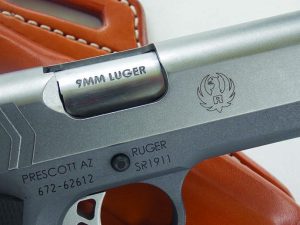
A 9mm marked 1911 is a pleasant shooter.
My early shooting years involved revolvers. It was a big step from the .22 to the .38 and then the .357 Magnum. It was an even bigger step to the 1911 automatic pistol. But the 1911 held my interest and I began a long association with the pistol. I am always interested in a new variation on the 1911. Some are done so cheaply I cringe but others are done well.
The Ruger SR1911 9mm is among the latter. The SR 1911 is a service grade handgun. That means it is reliable, accurate enough for any reasonable chore, and likely to endure for decades with minimal maintenance. It is a product of the consensus as outlined by Colonel Jeff Cooper, what is needed and no more. Good sights, a speed safety and a good trigger are all a 1911 really needs for personal defense. When you go much further you end up with features that may not be needed and a handgun that many shooters cannot afford.
Ruger’s original 1911 was a good full size pistol with a steel frame and 5-inch barrel. When Ruger introduced its 1911, it quickly gained a reputation as a reliable 1911 with good performance. The Commander-size pistol came next. The term Commander refers to a pistol with the slide and barrel shortened ¾ inch, hence the Commander configuration. There are both steel frame and aluminum frame Commander types. Ruger’s first short 1911 was a steel frame pistol followed by the lightweight frame. The initial offering in the SR1911 9mm is an aluminum frame.
Details
The pistol features a stainless steel slide and aluminum frame. The slide is well finished and the gray anodized frame gets high marks for above average finish. The SR1911 is a Series 70 type. This simply means there is no firing pin block or drop safety. The Ruger retains drop safety by using a lightweight firing pin that will not take a run forward if dropped. This is insured by an extra power firing pin spring. The low mass firing pin offers rapid lock time. The slide is nicely finished with the Ruger logo tastefully etched on the flats of the slide along with MADE IN USA. The cocking serrations are a rakish chevron type design that offer more leverage than most. The sights are Novak Low Mount, the premier combat pistol sight for decades. This sight gives a sharp sight picture. They feature the popular white dot outline. Modern sights such as the Novak are snag free yet are such good sighting equipment they make the difference between a 25-yard and a 50-yard gun.
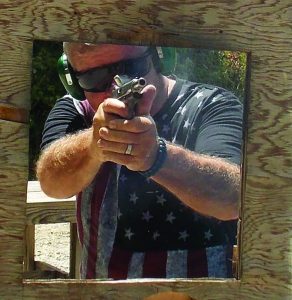
The Ruger SR1911 is controllable, reliable, accurate and overall a great performer.
The pistol features a skeletonized hammer . Hammer serrations are useful for good purchase when lowering the hammer. The beavertail grip safety is well designed and offers good handfit. The modern beavertail offers many advantages. Foremost is surety in deactivating the grip safety. Many of us use the thumb forward firing grip and this may lift the palm off of the grip frame. The memory bump of the Ruger prevents this from occurring. The beavertail may spread recoil out in the palm better than a standard unit but the real advantage is that the bore axis is slightly lowered. The slide lock safety features a positive indent. There is no loose motion in this critical component. The safety is slightly enlarged but not a gas pedal type. The pistol futures a standard recoil rod system without a full length guide rod. This simplified field stripping. The standard 1911 barrel bushing is retained. The grips are synthetic. They offer good adhesion when firing.
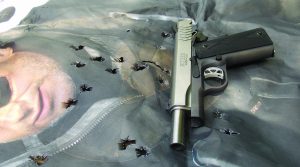
This Opsgear target suffered from the Ruger’s accuracy.
Mechanical aspects of the Ruger are interesting. The plunger tube isn’t staked on but permanently attached. As anyone that has used the 1911 hard for many years as I have understands the original is by no means permanently attached! I have seen plunger tubes loosen in high round count pistols. Re-staking is difficult. The Ruger will never have to be re-staked. The grip safety properly releases its hold on the trigger about half way into the safety’s travel, ideal for most of us. The slide lock is crisp and positive in operation. I like this combination of safety. The slide lock safety positively locks the action when applied. The slide is locked in place as well. The grip safety will spring into action and lock the trigger if the hand releases its hold on the grip safety. A feature not found on the .45 ACP SR1911 is a ramped barrel. I like this very much. Aluminum frames take a beating from the bullet nose. The ramped barrel offers superior cartridge case head support. The trigger action is crisp and breaks at an ideal 5.1 pounds. Overall the piece is true to the best features of the 1911 while offering several improvements that no 1911 fan should protest.
The lockup is positive and there is little lateral play in the slide. The pistol retains the advantages of the 1911 including a straight to the rear trigger compression, a low bore axis that limits muzzle flip, and a relatively thin grip that fits most hands well. The magazines are well made. The magazine springs are strong, very strong, and it was difficult to load eight rounds. I like this as they are positive in operation. Ruger advertised a 9 +1 capacity. It is possible to get the ninth round in the magazine but only with considerable effort. I think a nine shot 9mm is just fine. Speed, handling and accuracy, not capacity, is what this piece is about. By the 300-round mark the magazines were a tad easier to load.
Accuracy table, 25 yard bench rest
Load Velocity 5 shot group inches
Black Hills 115-gr. EXP 1211 fps 2.5 in.
Black Hills 124-gr. JHP 1080 fps 1.9 in.
Black Hills 124-grain JHP +P 1211 fps 2.25 in.
Gorilla Ammunition 135-gr. JHP 960 fps 2.25 in.
Fiocchi 115-grain Extrema 1120 fps 2.4 in.
Fiocchi 147-grain EXTREMA 899 fps 2.0 in.
G2 Research RIP 62-grain 1244 fps 2.6 in.
Wolf WPA 124-grain 1107 fps 3.9 in.
The 9mm 1911
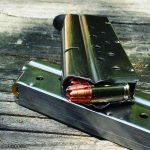
There were a handful of failures to fully close the slide during the first magazine. After this the pistol ran fine.
RIP Ammunition fed perfectly despite an unconventional bullet profile.
The chambering is a popular choice. The 9mm Luger offers economy, light recoil, good accuracy, and may be used well by those that cannot tolerate the recoil of the .45 ACP cartridge. Ruger’s introduction of the SR 1911 Commander-size pistol in 9mm isn’t without precedent. The first Commander, Colt’s 1949 model intended by US Army testing, was chambered for the 9mm cartridge. The 9mm Luger is popular for use in IDPA competition as well. The modern trend is to downrate the advantage of the .45 ACP over the 9mm. I am not one to do so. The .45 ACP offers a considerable advantage in wound ballistics. Until the laws of physics are changed this will remain so. But there are a number of 9mm loads that offer excellent wound potential. For most shooters, the combination of accuracy, light recoil and good wound potential are the ideal choice for personal defense.
Firing Tests
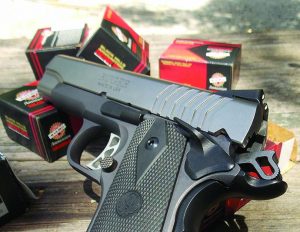
The Ruger SR1911 9mm is a first class all around defensive pistol. Light, reliable, accurate and powerful, it is a winner on all counts.
Initial firing was done with Black Hills 115-grain FMJ ammunition. The pistol was well lubricated along the long bearing surfaces, barrel hood, and cocking block. During the first magazine there were two failures to fully close the slide. When I dropped the slide on the second magazine, the first cartridge failed to fully chamber. After this initial break-in, the SR1911 never failed to feed, chamber, fire or eject. This break-in is the mark of a good tight 1911. (The second SR1911 did not experience a break-in period) 140 cartridges later I had homed in on the Opsgear targets and was producing center hits with every press of the trigger. The 1911’s good natural point, low bore axis and straight to the rear trigger compression add to excellent combat ability. The SR1911 9mm is as combat worthy a pistol as you will find.
Ammunition Performance
You cannot expect top velocity from a 4.25 inch barrel pistol but the 9mm loads tested gave good results. I fired a quantity of the Black Hills Ammunition 115-grain EXP, Black Hills Ammunition 124-grain JHP, the Gorilla Ammunition 135-grain JHP, and the Fiocchi 147-grain Extrema. This was to insure feed and cycle reliability with the popular bullet weights. There were no malfunctions. I also ran a number of cartridges of various weights and nose design left over from previous testing through the pistol. The Ruger never failed. I fired from the bench rest and checked 25 yard accuracy. The results are tabulated.
Leather
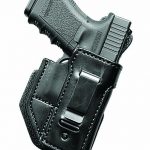
Jason Winnie’s well designed IWB holster is ideal for concealed carry with the Ruger SR1911 9mm.
The SR1911 9mm is light and flat. It will conceal well with a quality leather inside the waistband holster. I chose the Jason Winnie IWB with sweat guard and strong belt clip. (Jasonwinnie.com) This holster rides at the correct draw angle, is solidly attached to the belt, and offers an excellent balance of speed and security.
The Ruger SR1911 9mm is a reliable, accurate and practical handgun. I believe it will be among my most used 1911 handguns.



